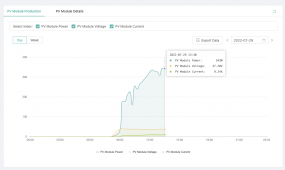[
{
"eid": 704xxxx,
"timestamp": 1658940840,
"actEnergyDlvd": 25953372.013,
"actEnergyRcvd": 0.002,
"apparentEnergy": 31042798.434,
"reactEnergyLagg": 8206472.850,
"reactEnergyLead": 12.251,
"instantaneousDemand": 6287.656,
"activePower": 6287.656,
"apparentPower": 6317.797,
"reactivePower": 502.796,
"pwrFactor": 0.997,
"voltage": 246.113,
"current": 51.339,
"freq": 60.000, // frequency
"channels": [
{
"eid": 177xxxx,
"timestamp": 1658940840,
"actEnergyDlvd": 12970955.588,
"actEnergyRcvd": 0.001,
"apparentEnergy": 15515662.048,
"reactEnergyLagg": 4100145.012,
"reactEnergyLead": 10.936,
"instantaneousDemand": 3153.715,
"activePower": 3153.715,
"apparentPower": 3169.323,
"reactivePower": 253.620,
"pwrFactor": 0.995,
"voltage": 123.488,
"current": 25.665,
"freq": 60.000
},
{
"eid": 177xxxx,
"timestamp": 1658940840,
"actEnergyDlvd": 12982416.425,
"actEnergyRcvd": 0.001,
"apparentEnergy": 15527136.386,
"reactEnergyLagg": 4106327.838,
"reactEnergyLead": 1.315,
"instantaneousDemand": 3133.941,
"activePower": 3133.941,
"apparentPower": 3148.474,
"reactivePower": 249.176,
"pwrFactor": 0.998,
"voltage": 122.625,
"current": 25.674,
"freq": 60.000
},
{
"eid": 177xxxx,
"timestamp": 1658940840,
"actEnergyDlvd": 0.000,
"actEnergyRcvd": 0.000,
"apparentEnergy": 0.000,
"reactEnergyLagg": 0.000,
"reactEnergyLead": 0.000,
"instantaneousDemand": 0.000,
"activePower": 0.000,
"apparentPower": 0.000,
"reactivePower": 0.000,
"pwrFactor": 0.000,
"voltage": 0.000,
"current": 0.000,
"freq": 60.000
}
]
},
{
"eid": 704xxxxx,
"timestamp": 1658940840,
"actEnergyDlvd": 25200098.256,
"actEnergyRcvd": 11844927.047,
"apparentEnergy": 40809421.289,
"reactEnergyLagg": 300738.904,
"reactEnergyLead": 8689620.728,
"instantaneousDemand": -1273.174,
"activePower": -1273.174,
"apparentPower": 1860.757,
"reactivePower": -577.720,
"pwrFactor": -0.675,
"voltage": 245.906,
"current": 15.116,
"freq": 60.000,
"channels": [
{
"eid": 177xxxxx,
"timestamp": 1658940840,
"actEnergyDlvd": 13368463.679,
"actEnergyRcvd": 5978358.703,
"apparentEnergy": 21043290.886,
"reactEnergyLagg": 259007.586,
"reactEnergyLead": 3825622.786,
"instantaneousDemand": -1418.656,
"activePower": -1418.656,
"apparentPower": 1452.365,
"reactivePower": -228.656,
"pwrFactor": -0.970,
"voltage": 123.329,
"current": 11.776,
"freq": 60.000
},
{
"eid": 177xxxxx,
"timestamp": 1658940840,
"actEnergyDlvd": 11831634.577,
"actEnergyRcvd": 5866568.344,
"apparentEnergy": 19766130.403,
"reactEnergyLagg": 41731.319,
"reactEnergyLead": 4863997.942,
"instantaneousDemand": 145.481,
"activePower": 145.481,
"apparentPower": 408.391,
"reactivePower": -349.064,
"pwrFactor": 0.368,
"voltage": 122.578,
"current": 3.340,
"freq": 60.000
},
{
"eid": 177xxxx,
"timestamp": 1658940840,
"actEnergyDlvd": 0.000,
"actEnergyRcvd": 0.000,
"apparentEnergy": 0.000,
"reactEnergyLagg": 0.000,
"reactEnergyLead": 0.000,
"instantaneousDemand": 0.000,
"activePower": 0.000,
"apparentPower": 0.000,
"reactivePower": 0.000,
"pwrFactor": 0.000,
"voltage": 0.000,
"current": 0.000,
"freq": 60.000
}
]
}
]




